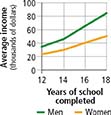American Issues  Connector: Education and American Society
Connector: Education and American Society

Students taking a standardized test
TRACK THE ISSUE
![]() What should be the goals of American education?
What should be the goals of American education?
Over time, the purpose of American education has changed. From an early focus on religion, schools turned to the promotion of democratic values. Today, they are placing a strong emphasis on performance standards. Use the timeline below to explore this enduring issue.
-
1600s–1700s Colonial Education
Schools emphasize religious study.
-
1852 Public Schools
Massachusetts passes first compulsory school attendance law in the United States.
-
1903 Du Bois-Washington Debate
Scholars debate the role of education in improving African Americans’ lives.
-
1926 Scholastic Aptitude Test
The Scholastic Aptitude Test (SAT) is first administered.
-
2001 No Child Left Behind Act
Federal law tries to raise student performance through standardized testing and other measures.
Education and Income

DEBATE THE ISSUE
Standardized Testing Standardized tests are used both to assess students and to hold teachers accountable for meeting standards. But critics argue that an emphasis on testing is hurting American schools.
“We have learned a great deal about the nature of teaching and learning, and we know that students need to have opportunities to construct knowledge and connect that knowledge to what they already know. However, many … [standardized tests] still continue to focus on the memory of isolated facts which are destined to be forgotten.”
—Marilyn Bizar, North Central Regional Educational Laboratory
“You can’t figure out whether schools are doing a good job unless you have some way of measuring how much their students are learning…. A guarantee by the national government of a decent education for every child is a noble cause, and so is the idea that all Americans will acquire a common body of skills and knowledge as they come of age.”
—Nicholas Lemann, writer, The New Yorker
 TRANSFER Activities
TRANSFER Activities
- Compare Why does Bizar oppose standardized testing? Why does Lemann support standardized testing?
- Analyze Do you think that the increase in standardized testing will cause students’ achievement scores to rise? Explain.
- Transfer Use the following Web site to see a video, try a WebQuest, and write in your journal. Web Code: neh-9302




